As you must be already aware, animals with green eyes are the rarest. Yes, if this news shocks you, only 2% of mammals worldwide genuinely have green eyes, making it the rarest eye color globally.
It may surprise you to learn that low melanin levels are a result of a genetic mutation, that leads to a person having green eyes. However, green eyes are basically colorless. That’s correct—strange yet real! Although the irises themselves lack pigment, green eyes appear to be a beautiful hue of emerald to those on the outside.
Therefore, we could not afford to skip the opportunity to compile some stunning species of animals with green eyes and share them with you in an engaging blog.
Hence, let’s get started and discover 30 Fascinating Animals from Across the Globe Flaunting Their Green Eyes. Happy scrolling!
Animals with Green Eyes
1. Egyptian Mau
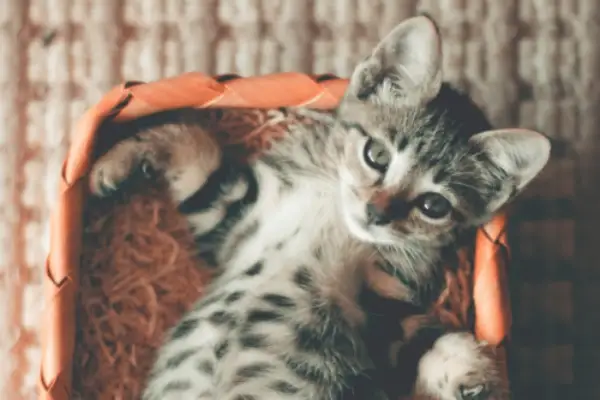
- Scientific name – Felis catus
- Size – overall height of 8 to 10 inches, body length of 12 to 15 inches
- Habitat – Easily found domestic cat, found as street cats in Egypt and rare everywhere else
- Diet – It’s best to keep them on a high-protein, meat-based diet.
The Egyptian Mau is a very special breed and the most agile of all domestic cats. It is admired for its graceful charisma, muscular coat with vivid spots, and gooseberry green eyes.
You can be in awe after just one glance. Furthermore, this is a breed-specific attribute. Isn’t it amazing?
2. Oriental Shorthair
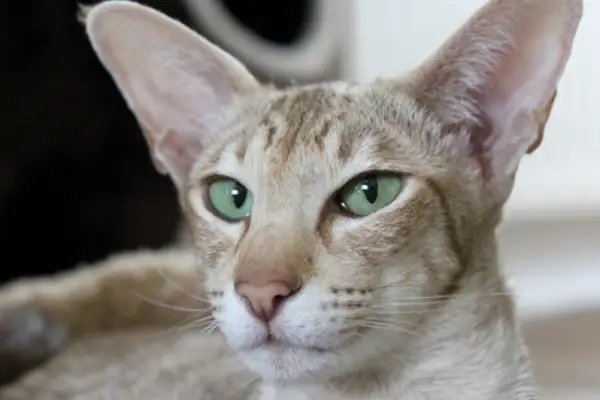
- Scientific name – Felis catus
- Size – overall height of 23-28 cm, and body length of 28-36 cm
- Habitat – Easily found domestic cats in the U.S. and Thailand
- Diet – High-protein, meat-based diet
Except for those having white fur, all Oriental shorthairs have green eyes. As a result, when searching for animals with green eyes, they are among the top results. A few Oriental shorthair coats can change color as well.
They have a triangular head form, a slim body, and eyes that are striking olive-green in color. Additionally, we observe a clever, friendly, and quite vocal nature in most of these cats. They also enjoy living in groups or pairs and adore social interaction.
3. Smith’s Green-Eyed Gecko

- Scientific name – Gekko smithii
- Size – up to 35.5 cm
- Habitat – Forest
- Diet – insects such as grasshoppers
The giant forest gecko, or Gekko smithii, is a lizard indigenous to Indonesia and the Southeast Asian continent. As its name implies, among other animals with green eyes, Smith’s Green-eyed Gecko has to make the list for having the most beautiful, enormous, and complete emerald eyes with a black split.
These geckos can grow impressively large, up to 35.5 cm.
4. Green-Eye

- Scientific name – Chlorophthalmus agassizi
- Size – up to 40 cm
- Habitat – continental slopes and shelves
- Diet – Feeds mainly on bottom-living invertebrates and pelagic crustaceans like euphausiids, decapods and mysids
The Green-eye are aulopiform marine fishes that live in deep waters. They have huge eyes and heads that possess a beautiful iridescent pattern.
Their bodies are somewhat compressed and thin. Their iridescent and fluorescent eyes are likewise the separating characteristics, and this is why they rank among the top few animals with green eyes when you search for them.
Though the largest species, the Short-nosed Green-eye, can reach a length of 40 cm, most other green-eye species are much smaller.
Their bodies are yellowish to blackish brown, with some species having cryptic markings.
5. Nebelung

- Scientific name – Felis catus
- Size – height up to 9 to 13 inches
- Habitat – a rare pedigree breed of domestic cat originating from the US
- Diet – High proportion of meat
The Nebelung is a rare pedigree breed of domestic cat. These are large animals with green eyes (crystal-like and wide-set), lengthy bodies, dense coats, and a friendly demeanor.
The cat, sometimes known as the Long-haired Russian Blue, is similar to the Russian Blue but has longer, silkier fur.
6. Coquerel’s Sifaka
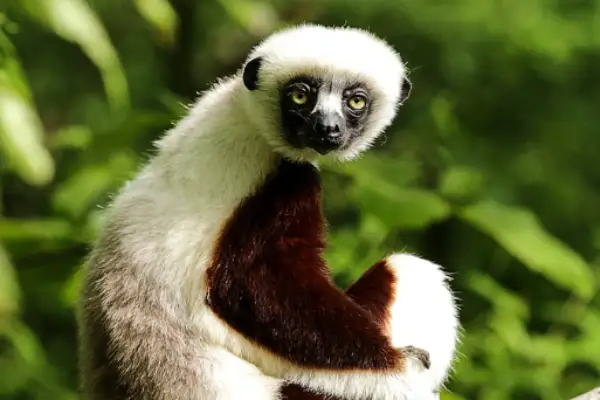
- Scientific name – Propithecus coquereli
- Size – body length up to 42-50 cm
- Habitat – tropical-dry and lowland forests
- Diet – primarily consumes leaves, flowers, fruit, bark, and dead wood and occasionally insects
Native to northwest Madagascar, the Coquerel’s sifaka is an adorable, medium-sized, diurnal lemur.
This lemur has a hint of yellowish in its otherwise green eyes, unlike the previous animals with green eyes on the list. Still, their eyes are as flawlessly round as a button. Bright and wide open.
7. Giant Green-eyed Robber Fly

- Scientific name – Microstylum morosum
- Size – 3 to 50 mm
- Habitat – open habitats that have a diverse insect prey base, such as prairies and scrub
- Diet – Preys on insects such as bumblebees, grasshoppers, and butterflies
A massive robber fly with enormous eyes, a vibrant shade of emerald that seems almost too large for its head!
The Microstylum morosum is one of those strange animals with green eyes that, once it’s on your land, you won’t be able to ignore because of its eyes, sleek, nearly hairless body, and big size.
8. Tarsiers
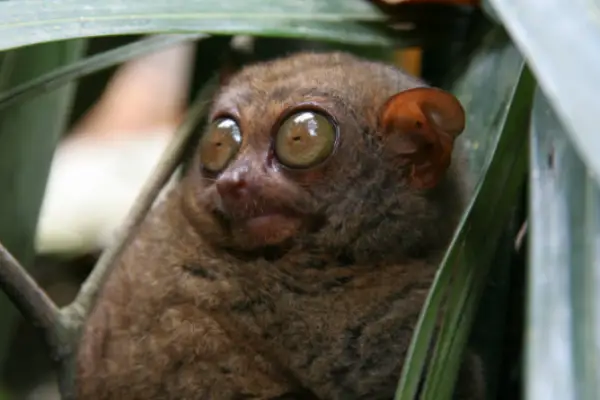
- Scientific name – Tarsius
- Size – height up to 9cm -16cm
- Habitat – Forests, mangroves and scrub
- Diet – mostly insectivorous
The Philippine tarsier is one of the tiniest primates, standing about 85 to 160 mm tall.
It is challenging to spot because of its modest size. But do you know what helps in the same? Their eyes are olive green. Of all the mammals, tarsiers have the biggest eyes in proportion to their body size.
The diameter of each eyeball is around 16 millimeters, making them the same size as the tarsier’s entire brain.
Tarsiers can spin their heads approximately 360 degrees, but they are unable to rotate their enormous eyes.
9. Leopards
- Scientific name – Panthera pardus
- Size – average 84 inches in length, and 60 to 70 cm in shoulder height
- Habitat – forests, subtropical and tropical regions, savannas, grasslands, deserts, and rocky and mountainous regions
- Diet – Carnivorous
Leopards usually have green or blue eyes with occasional yellow undertones. But the most common eye color is green only.
Leopards sport the most intriguing look. Their skin is peach brown, and they have a long tail with a rosette pattern all over their body. Despite how magnificent they may appear, having the most captivating green eyes, make sure you maintain your distance from this animal.
10. Green Mantis

- Scientific name – Mantis religiosa
- Size – 2 to 5 inches (5–12 cm)
- Habitat – tropical rainforest, deserts, grasslands and meadowlands
- Diet – aphids, leafhoppers, mosquitoes, caterpillars, and other soft-bodied insects when young. Later they will eat larger insects, beetles, grasshoppers, crickets, and other pest insects
This creature has the most alienating appearance of all the animals with green eyes. The head of the praying mantis has a triangle-like shape, with two globe-like, entirely green eyes on either side. Plus, a black dot appears to be a pupil in the center of each eye.
11. Green-Eyed Flower Bee
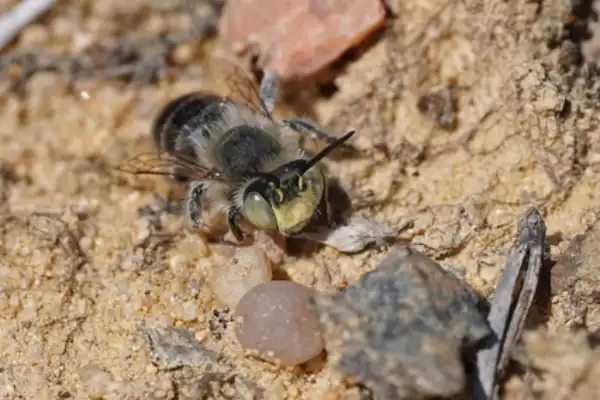
- Scientific name – Anthophora bimaculata
- Size – 8–9 mm long
- Habitat – nests in lower locating sandy areas: inland dunes, sand pits, forest edges, and forest clearings
- Diet – nectar and pollen
As its name suggests, upon one close look at the green-eyed flower bee, you’ll find enormous green eyes (for an insect head) staring back at you. Despite being comparable in size, you cannot mistake this one for a honey bee.
This bug might not be that impressive aside from its notable green eyes, and it may even deserve a spot on a list of bizarre animals with green eyes.
12. Dragonhunter
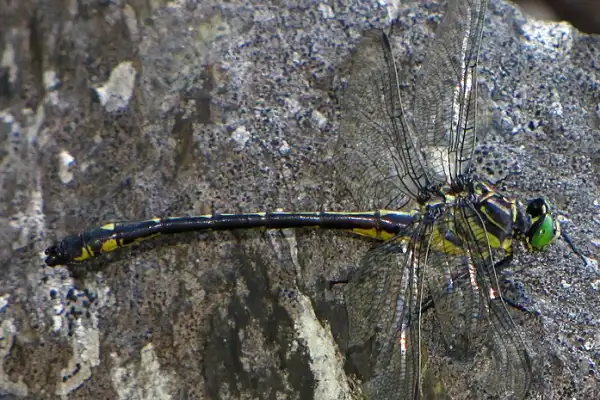
- Scientific name – Hagenius brevistylus
- Size – 73 to 90 mm long
- Habitat – banks of forested streams and moderate to fast-flowing rivers
- Diet – they prey on smaller insects, even Monarch Butterflies and large skimmer dragonflies too
It’s a dragonfly, pretty huge for its community, and its most remarkable feature is the entirely leaf-green eyes.
The adult individuals of this species have a tiny black head with a yellow-striped face and typical green eyes.
While black and yellow markings, with two thick yellow stripes on the sides of the thorax, distinguish their body.
13. Great Pondhawk
- Scientific name – Erythemis vesiculosa
- Size – 75-100mm
- Habitat – Northern Mexico, and the US; limited to Texas & Oklahoma
- Diet – insectivorous
The most distinctive characteristic of all great pond hawks is their vibrant yet muddy emerald eyes. Along with typical green eyes, each one has a long, slender abdomen with brown bands and a swollen base.
Additionally, its uniform green thorax lacks any characteristics, such as stripes, that make it easier to identify them.
14. Green-Eyed Horse Flies
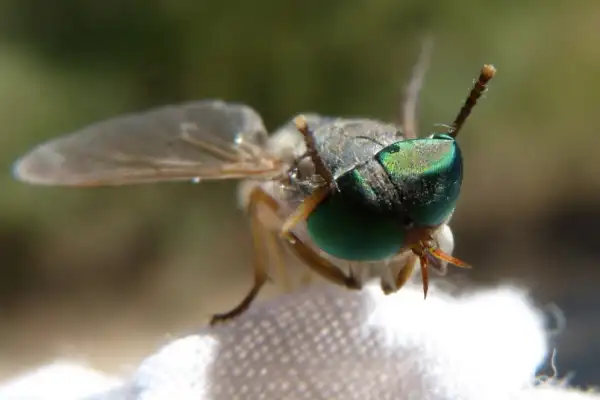
- Scientific name – Tabanus fulvulus
- Size – 13.3 mm
- Habitat – brushy or low-lying pasture areas near creeks, streams, or damp soil regions
- Diet – plant nectar and other plant juices
This horsefly is a true fly, having the most stunning emerald eyes you would ever see on an insect.
It so rightfully deserves a spot among animals with green eyes.
True flies have an intriguing feature: the females have mouthparts that resemble scissor blades, which they use to sever skin so the horsefly may absorb the blood.
15. Green-Eyed Tree Frog
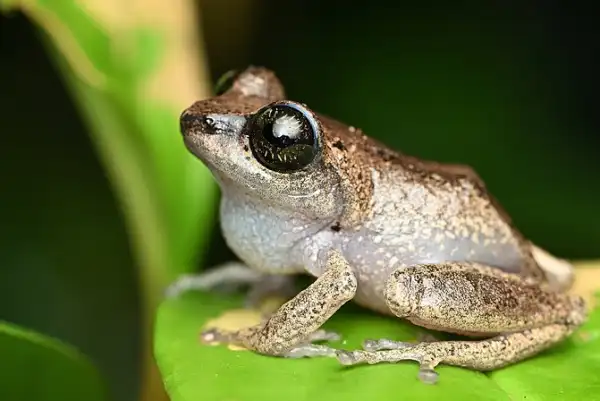
- Scientific name – Lithobates vibicarius
- Size – 6–9 cm in snout-vent length
- Habitat – lower regions of montane rainforest as they prefer dense woods and sometimes water clearings or pastures
- Diet – insects, spiders, centipedes, and other invertebrates, while tadpoles feed on organic detritus and plant material
Lithobates vibicarius is a species of frog found in highland rainforests in Costa Rica and western Panama. Its common names are the green-eyed frog (because of its green eyes) & the Rancho Redondo frog (because of its original locality in Costa Rica).
With a snout-vent length of 6–9 cm, Lithobates vibicarius frogs are comparatively large. Juveniles are typically green, although the dorsal pigmentation can vary in adults, appearing golden, greenish, or dull brown.
16. The Green-Eye Dancing Shrimp
- Scientific name – Cinetorhynchus reticulatus
- Size – maximum length of 6 cm
- Habitat – tropical waters of the Indo-Pacific region, including the Red Sea
- Diet – algae, parasites, and plankton
Also called Hingebeak Shrimp, Reticulated Hingebeak Shrimp, and Green-eyed Dancing Shrimp.
Found in colonies, under overhangs of coral and rocky reefs, in holes and crevices, and among outcrops of coral. The movable rostrum, or beak, of hinge-beak shrimps, is characteristically tilted upwards.
Its nickname, “Dancing Shrimp,” comes from how frequently it moves and stops suddenly.
Its body has stripes in a varying pattern of red and white. The green eyes, however, are the most contrasting feature.
17. Yellow Fly
- Scientific name – Diachlorus ferrugatus
- Size – around 1 cm
- Habitat – deeply shaded areas in root mats of cypress, shingle oak, and other woody plants
- Diet – mainly pollen and nectar feeders
Diachlorus ferrugatus, the true yellow fly, has the most striking appearance with its two purple bands between dazzling blue-green eyes.
Adults have black forelegs and yellow bodies, mid- and hindlegs, and are around 1 cm long.
They also fly silently, and their bite is typically the first indication that humans have encountered them.
18. Giant Ragweed Fruit Fly
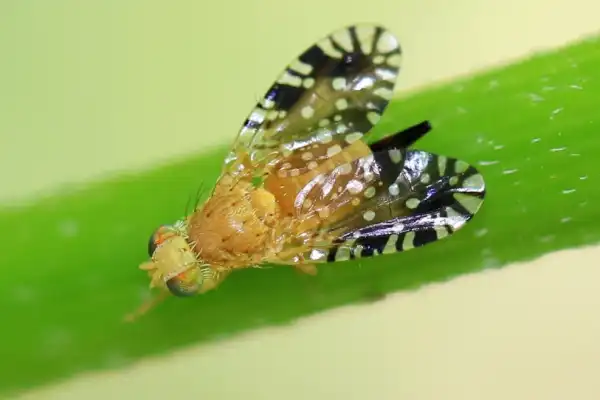
- Scientific name – Euaresta festiva
- Size – 4-7 mm
- Habitat – plants; Ambrosia, Xanthium, and Dicoria
- Diet – flowers and seeds
Usually seen crawling around on huge ragweed, you best avoid these colorful little fruit flies if you suffer from hay fever. With its distinctive black pattern on its wings and vibrant lime green eyes, the giant ragweed fruit fly, Euaresta festiva, has an exceptional appearance.
19. Common Bamboo Viper
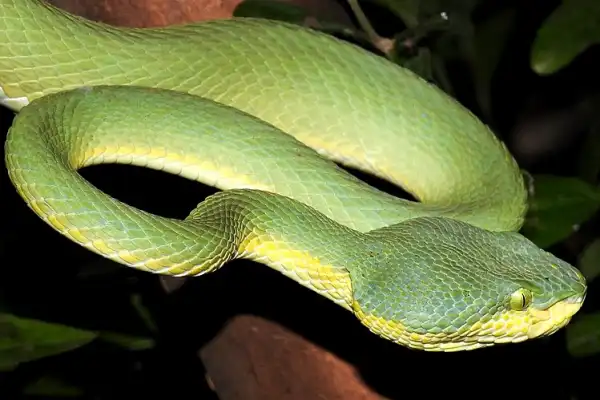
- Scientific name – Craspedocephalus gramineus
- Size – 3.25 feet
- Habitat – southern India especially widespread in a large area of Tamil Nadu
- Diet – lizards, rats, and birds
The most common pit viper in India is the bamboo pit viper, which is really the sole pit viper present in the majority of the peninsula’s deep woods.
It is simple to identify by looking for its distinctive triangular head, which is significantly wider than its neck, green dorsal markings that are either richly or faintly black, and yellow belly. Also, the eyes of bamboo pit vipers are green with vertical pupils.
20. Indris (Indri indri)
- Scientific name – Indri Indri
- Size – 62–72 cm
- Habitat – primary and secondary lowland and mid-altitude rainforest
- Diet – herbivorous and eat a variety of plants and plant parts
It is the largest species of lemur, has a black body with white markings, and small yet perfectly round, bright green eyes staring right at you. The indri indri is undoubtedly an astounding animal. They only live around Eastern Madagascar.
21. Orinoco Crocodile
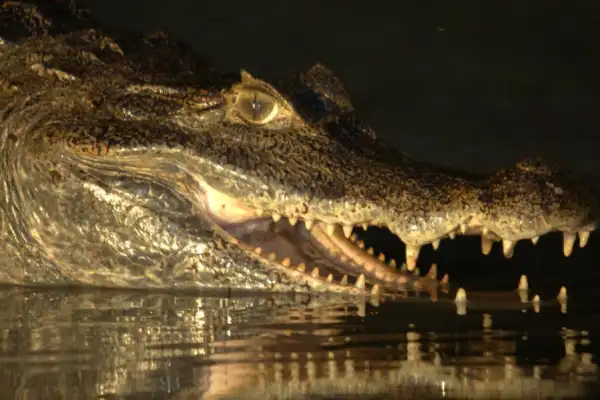
- Scientific name – Crocodylus intermedius
- Size – 4.1 to 5.2 m
- Habitat – aquatic-land areas within the Orinoco basin
- Diet – piscivorous diet
Crocodile eyes, like this one in particular, are engineering marvels. These animals with green eyes can see around every angle, detect various targets, retract during combat, and see in the dark.
However, the Orinoco Crocodile, which lives in freshwater zones in northern South America, is a severely endangered species.
22. Pelegrina pervaga
- Scientific name – Pelegrina pervaga
- Size – about 4 mm
- Habitat – found in open habitats like fields, shrubs, and bogs
- Diet – feed on ants on or near the ground, but not restricted to it
Pelegrina pervaga is a species of jumping spider. Above all, they are known for having the finest vision of any spider species.
Jumpers have eight dazzling green metallic eyes and can see practically in all directions at once. Hence, they happen to be as good stalkers as tigers and lions in the wild.
23. Gymnochiromyia flavella
- Scientific name – Gymnochiromyia flavella
- Size – about 2 mm
- Habitat – mixed coast live oak chaparral habitat on sandy soils
- Diet – feed on flowers
Gymnochiromyia flavella is a golden fly with absolutely stunning green eyes that are just too enormous for its head. It can exist throughout the whole Palearctic. Additionally, they resemble typical house bees, but they are much smaller.
24. Russian Blue Cat
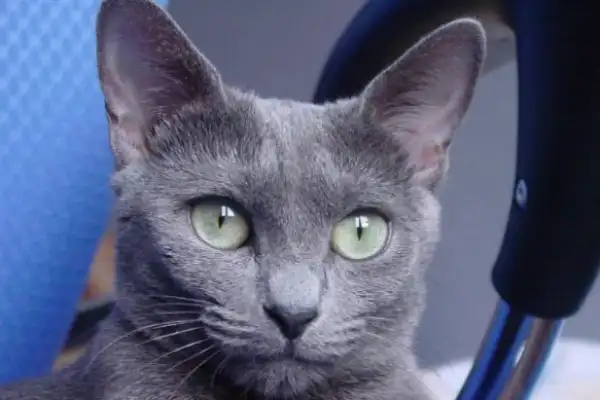
- Scientific name – Felis catus
- Size – approximately 10 inches tall
- Habitat – Easily found domestic cat in Russia
- Diet – High-protein, meat-based diet
The most well-known features of the Russian Blue are its two layers of short, dense fur, its pinkish lavender or mauve paws, its bright green eyes, and the blue-grey-black coat.
The bluish-gray hue is caused by the black gene’s diluted expression.
Its remarkable physical attributes thus make it stand out among the other animals with green eyes.
25. Hine’s Emerald
- Scientific name – Somatochlora hineana
- Size – 60-65 millimeters
- Habitat – calcareous, spring-fed marshes and sedge meadows that grow over dolomite bedrock
- Diet – smaller flying insects, including mosquitoes, biting flies, and gnats
The metallic bodies of Hine’s emerald dragonflies are slender and possess shades of green, brown, or black. The dragonfly’s thorax is marked by two prominent yellow lateral stripes that eventually turn white with age.
Their massive eyes, which have about 360 degrees of peripheral vision, are brilliantly colored in an emerald-green hue, which makes them noticeable among other animals with green eyes.
26. Peacock Spider

- Scientific name – Maratus volans
- Size – 2–6 mm
- Habitat – certain areas in Australia
- Diet – flies, moths, winged ants, and grasshoppers, as well as any small insects they can capture
These little Australian spiders are as adorable as they are little. Each of the eight metallic green eyes on a peacock spider possesses a telescopic lens and an ultraviolet-sensitive photoreceptor.
The length of the male and female flying peacock spiders is a mere 0.20 inches! Furthermore, plenty of other amazing facts about this arachnid can make you go AWW!
27. Great Green Bush Cricket
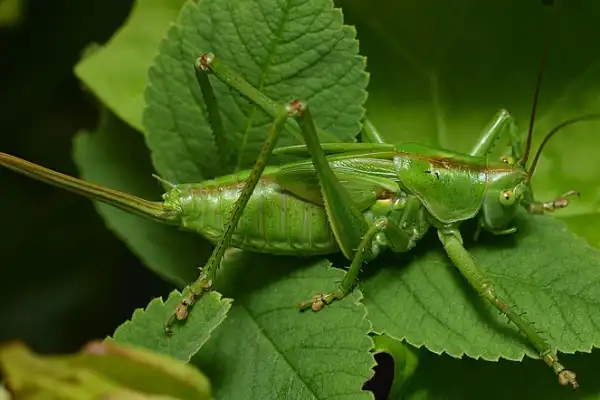
- Scientific name – Tettigonia viridissima
- Size – nearly 7 cm long
- Habitat – trees and grassland dotted with patches of scrub
- Diet – flies, caterpillars, and other insect larvae
Except for a brown, rust-colored stripe on top of their bodies, they are often entirely green, although a few can have more yellowish bodies or legs.
Aside from that, their eyes are all green, except for a darker pupil that appears like a dot. Further, their antennae are long, reaching a maximum length of three times the body length.
28. Northern Bush Katydid
- Scientific name – Scudderia septentrionalis
- Size – up to 5 mm
- Habitat – habitats with lots of plants
- Diet – feed on flowers of assorted, often herbaceous plants
The northern bush katydid (Scudderia septentrionalis) is a common katydid that is all green animals with green eyes, much like the previous one.
It resembles a leaf to assume an effective camouflage. When it’s not hiding, it may push itself forward by leaping with the strength of its back legs.
29. Swamp Cicada
- Scientific name – Neotibicen tibicen
- Size – around 3.5 cm
- Habitat – forest, shrubland, meadow, woodland, urban or residential area
- Diet – xylem sap from roots of grasses, forbs, or woody plants
This predominantly green and black insect with incredibly deep & dark green eyes is known as the swamp cicada or morning cicada.
Because Neotibicen tibicen is most active in the morning, that is how it gets its name – morning cicada.
30. Mantidfly
- Scientific name – Mantispidae
- Size – 20 to 35 mm
- Habitat – grasslands and other open habitats
- Diet – smaller insect, mite, or other arthropod
Within the order Neuroptera, the Mantispidae family comprises small to moderately large insects.
Their brilliant metallic green eyes, which can occasionally shimmer with different hues, make them stand out on our list.
Furthermore, most of them mimic wasps and appear brownish with tints of green, yellow, and rarely red, making them one of the weirdest insect families.
CONCLUSION
Our thoughtfully curated list of animals with green eyes comes to an end here. It’s one of the unique features of animals that we hardly observe around the world. Our list features 30 stunning animals flaunting their green eyes.
Some cat species are at the top of the list, while later on, bugs take over the spotlight. We sincerely hope you enjoyed reading this article. Stay tuned until we have something new to share.
Also Read:

Anjali Prasad, a B. Pharm. graduate who works as a content writer for HowItSee, is based in Delhi. Except for her, not many people take the typical road from healthcare to writing. Her love of writing stemmed from her involvement in the college literature society and her early journaling at the age of 7. Hence, the love of learning and the spirit of exploration are what drew her to this career. You can find her on common social media like Instagram.
